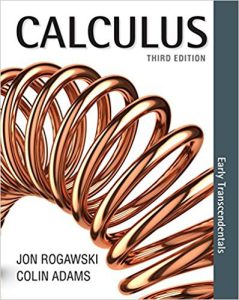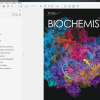(eBook PDF) Calculus Early Transcendentals 3rd Edition
$50.00 Original price was: $50.00.$35.00Current price is: $35.00.
(eBook PDF) Calculus Early Transcendentals 3rd Edition – Instant Download
(eBook PDF) Calculus Early Transcendentals 3rd Edition – Digital Ebook – Instant Delivery Download

Product details:
- ISBN-10 : 1464114889
- ISBN-13 : 978-1464114885
- Author: W. H. Freeman
The most successful calculus book of its generation, Jon Rogawski’s Calculus offers an ideal balance of formal precision and dedicated conceptual focus, helping students build strong computational skills while continually reinforcing the relevance of calculus to their future studies and their lives.
Guided by new author Colin Adams, the new edition stays true to the late Jon Rogawski’s refreshing and highly effective approach, while drawing on extensive instructor and student feedback, and Adams’ three decades as a calculus teacher and author of math books for general audiences.
Table contents:
Chapter 1: Precalculus Review
1.1 Real Numbers, Functions, and Graphs
1.2 Linear and Quadratic Functions
1.3 The Basic Classes of Functions
1.4 Trigonometric Functions
1.5 Inverse Functions
1.6 Exponential and Logarithmic Functions
1.7 Technology: Calculators and Computers
Chapter Review Exercises
Chapter 2: Limits
2.1 Limits, Rates of Change, and Tangent Lines
2.2 Limits: A Numerical and Graphical Approach
2.3 Basic Limit Laws
2.4 Limits and Continuity
2.5 Evaluating Limits Algebraically
2.6 Trigonometric Limits
2.7 Limits at Infinity
2.8 Intermediate Value Theorem
2.9 The Formal Definition of a Limit
Chapter Review Exercises
Chapter 3: Differentiation
3.1 Definition of the Derivative
3.2 The Derivative as a Function
3.3 Product and Quotient Rules
3.4 Rates of Change
3.5 Higher Derivatives
3.6 Trigonometric Functions
3.7 The Chain Rule
3.8 Implicit Differentiation
3.9 Derivatives of General Exponential and Logarithmic Functions
3.10 Related Rates
Chapter Review Exercises
Chapter 4: Applications of the Derivative
4.1 Linear Approximation and Applications
4.2 Extreme Values
4.3 The Mean Value Theorem and Monotonicity
4.4 The Shape of a Graph
4.5 L’Hopital’s Rule
4.6 Graph Sketching and Asymptotes
4.7 Applied Optimization
4.8 Newton’s Method
Chapter Review Exercises
Chapter 5: The Integral
5.1 Approximating and Computing Area
5.2 The Definite Integral
5.3 The Indefinite Integral
5.4 The Fundamental Theorem of Calculus, Part I
5.5 The Fundamental Theorem of Calculus, Part II
5.6 Net Change as the Integral of a Rate
5.7 Substitution Method
5.8 Further Transcendental Functions
5.9 Exponential Growth and Decay
Chapter Review Exercises
Chapter 6: Applications of the Integral
6.1 Area Between Two Curves
6.2 Setting Up Integrals: Volume, Density, Average Value
6.3 Volumes of Revolution
6.4 The Method of Cylindrical Shells
6.5 Work and Energy
Chapter Review Exercises
Chapter 7: Techniques of Integration
7.1 Integration by Parts
7.2 Trigonometric Integrals
7.3 Trigonometric Substitution
7.4 Integrals Involving Hyperbolic and Inverse Hyperbolic Functions
7.5 The Method of Partial Fractions
7.6 Strategies for Integration
7.7 Improper Integrals
7.8 Probability and Integration
7.9 Numerical Integration
Chapter Review Exercises
Chapter 8: Further Applications of the Integral and Taylor Polynomials
8.1 Arc Length and Surface Area
8.2 Fluid Pressure and Force
8.3 Center of Mass
8.4 Taylor Polynomials
Chapter Review Exercises
Chapter 9: Introduction to Differential Equations
9.1 Solving Differential Equations
9.2 Models Involving y^’=k(y-b)
9.3 Graphical and Numerical Methods
9.4 The Logistic Equation
9.5 First-Order Linear Equations
Chapter Review Exercises
Chapter 10: Infinite Series
10.1 Sequences
10.2 Summing an Infinite Series
10.3 Convergence of Series with Positive Terms
10.4 Absolute and Conditional Convergence
10.5 The Ratio and Root Tests
10.6 Power Series
10.7 Taylor Series
Chapter Review Exercises
Chapter 11: Parametric Equations, Polar Coordinates, and Conic Sections
11.1 Parametric Equations
11.2 Arc Length and Speed
11.3 Polar Coordinates
11.4 Area and Arc Length in Polar Coordinates
11.5 Conic Sections
Chapter Review Exercises
Chapter 12: Vector Geometry
12.1 Vectors in the Plane
12.2 Vectors in Three Dimensions
12.3 Dot Product and the Angle Between Two Vectors
12.4 The Cross Product
12.5 Planes in Three-Space
12.6 A Survey of Quadric Surfaces
12.7 Cylindrical and Spherical Coordinates
Chapter Review Exercises
Chapter 13: Calculus of Vector-Valued Functions
13.1 Vector-Valued Functions
13.2 Calculus of Vector-Valued Functions
13.3 Arc Length and Speed
13.4 Curvature
13.5 Motion in Three-Space
13.6 Planetary Motion According to Kepler and Newton
Chapter Review Exercises
Chapter 14: Differentiation in Several Variables
14.1 Functions of Two or More Variables
14.2 Limits and Continuity in Several Variables
14.3 Partial Derivatives
14.4 Differentiability and Tangent Planes
14.5 The Gradient and Directional Derivatives
14.6 The Chain Rule
14.7 Optimization in Several Variables
14.8 Lagrange Multipliers: Optimizing with a Constraint
Chapter Review Exercises
Chapter 15: Multiple Integration
15.1 Integration in Two Variables
15.2 Double Integrals over More General Regions
15.3 Triple Integrals
15.4 Integration in Polar, Cylindrical, and Spherical Coordinates
15.5 Applications of Multiple Integrals
15.6 Change of Variables
Chapter Review Exercises
Chapter 16: Line and Surface Integrals
16.1 Vector Fields
16.2 Line Integrals
16.3 Conservative Vector Fields
16.4 Parametrized Surfaces and Surface Integrals
16.5 Surface Integrals of Vector Fields
Chapter Review Exercises
Chapter 17: Fundamental Theorems of Vector Analysis
17.1 Green’s Theorem
17.2 Stokes’ Theorem
17.3 Divergence Theorem
Chapter Review Exercises
Appendices
A. The Language of Mathematics
B. Properties of Real Numbers
C. Induction and the Binomial Theorem
D. Additional Proofs
Answers to Odd-Numbered Exercises
References
Index
People also search:
Calculus Early Transcendentals 3rd
Calculus Early Transcendentals 3rd edition
Calculus Early Transcendentals 3rd pdf
Calculus Early Transcendentals 3rd pdf free
Calculus Early Transcendentals 3rd download scribd



